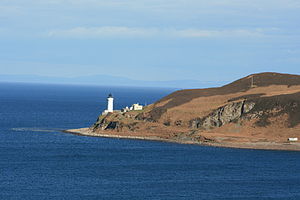Davaar
| Davaar Island | ||
|---|---|---|
| Davaar Island | ||
| Waters | Firth of Clyde | |
| Geographical location | 55 ° 25 '22 " N , 5 ° 32' 28" W | |
|
|
||
| length | 1.2 km | |
| width | 800 m | |
| surface | 52 ha | |
| Highest elevation | 115 m | |
| Residents | uninhabited | |
| Lighthouse on Davaar | ||
Davaar Island ( Scottish Gaelic : Eilean Dà Bhàrr ) is an uninhabited tidal island belonging to Scotland in the Firth of Clyde . Davaar is in front of Campbeltown , in the Campbeltown Loch . At low tide, the island can be reached in 40 minutes via a narrow land road.
Davaar was known as Sanct Barre between 1449 and 1508 . The modern name Davaar comes from the older name Do Bharre - thy St Barre .
A lighthouse was built on the island in 1854 by David and Thomas Stevenson . In 1983 the lighthouse was modernized and has been working fully automatically ever since. In 2001 there were still two people living on the island, but in 2011 it was already uninhabited.
Davaar is known for its seven caves. The artist Archibald MacKinnon painted an oversized crucifixion scene in one of them. The painting was defaced in the meantime, but restored in its original condition in 2006.
Goats , minks and sheep are native to the island .
There are unofficial postage stamps on the island that have been issued since 1964.
Individual evidence
Web links
- Page about the island and its surroundings ( Memento from April 26, 2011 in the Internet Archive )
- Report on the defacement of the mural (Engl.)



